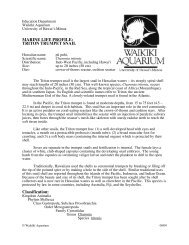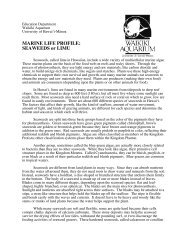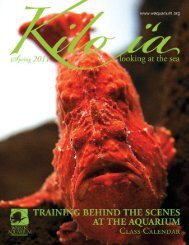You also want an ePaper? Increase the reach of your titles
YUMPU automatically turns print PDFs into web optimized ePapers that Google loves.
Aquarist Norton Chan has had his hands full lately with all <strong>the</strong> newborns arriving<br />
at <strong>the</strong> <strong>Aquarium</strong>. First it was <strong>the</strong> bigfin squid. Now he’s raising seahorses.<br />
In early August, one of <strong>the</strong> male seahorses in Gallery 3 began to look like<br />
he was in a fa<strong>the</strong>rly way. The seahorse, which is one of <strong>the</strong> species found in local waters,<br />
was placed in a nursery tank behind <strong>the</strong> scenes, where he gave birth several days<br />
later to around 500 offspring — all perfectly formed seahorses about 4 millimeters<br />
high. And it’s obviously <strong>the</strong> season: a second small herd was born in early September.<br />
And while <strong>the</strong>re is all this activity behind <strong>the</strong> scenes at <strong>the</strong> <strong>Aquarium</strong>, seahorses in<br />
<strong>the</strong> wild also appear to be enjoying something of a resurgence. It used to be that seeing<br />
a seahorse was a rare experience — now <strong>the</strong>y are popping up everywhere.<br />
“People have found <strong>the</strong>m in ankle-deep water at Magic Island; <strong>the</strong>y’ve been seen<br />
along <strong>the</strong> shoreline at Pearl Harbor and in Käne‘ohe Bay; and <strong>the</strong>re are lots at piers and<br />
harbors like <strong>the</strong> Käne‘ohe Bay Yacht Club and <strong>the</strong> Ala Wai,” Chan says.<br />
Kilo iça<br />
Pictured at left: Hippocampus kuda can change colors <strong>from</strong> black to<br />
yellow to cream. At right: These young seahorses are among <strong>the</strong> herd<br />
that grew up at <strong>the</strong> <strong>Aquarium</strong> and is now breeding.<br />
Photos: Alice Keesing.<br />
ursery<br />
NSEAHORSE<br />
This phenomenon, where a species has a sudden resurgence,<br />
often happens thanks to a fluke of good conditions. If a high<br />
number of juveniles survive in one breeding season, <strong>the</strong> population<br />
can quickly build on itself. The same thing has recently been<br />
witnessed in <strong>the</strong> bigfin squid.<br />
The <strong>Aquarium</strong> has long worked on breeding and raising<br />
seahorses. Of course, one of <strong>the</strong> many fascinating things about<br />
<strong>the</strong>se animals is <strong>the</strong>ir breeding habits. It starts with daily bonding<br />
activities as <strong>the</strong> seahorse couple swim toge<strong>the</strong>r each morning with<br />
<strong>the</strong>ir tails entwined. When it’s time to mate, <strong>the</strong> female deposits<br />
her eggs into a brood pouch on <strong>the</strong> male’s belly, where <strong>the</strong>y are<br />
fertilized. The fa<strong>the</strong>r carries <strong>the</strong> developing embryos until <strong>the</strong>y are<br />
fully formed. His labor can last up to a day and a half.<br />
The young emerge as fully formed — and hungry — seahorses.<br />
Because <strong>the</strong>y have no teeth or true stomach, food passes through <strong>the</strong>ir<br />
digestive tract very quickly, making <strong>the</strong>m voracious eaters. Chan<br />
started <strong>the</strong> new herd on copepods and newly hatched brine shrimp.<br />
The knowledge gained while raising <strong>the</strong>se seahorses can ultimately<br />
help protect <strong>the</strong>se animals in <strong>the</strong> wild. Around <strong>the</strong> world,<br />
many species of seahorses are threatened by overfishing. They are<br />
in high demand for medicinal purposes in Asia and many more are<br />
sold as souvenirs. The endearing fish are also popular aquarium<br />
pets, and <strong>the</strong> recent population peak in Hawaiçi has resulted in an<br />
influx of wild-caught seahorses into <strong>the</strong> pet stores.<br />
But Chan urges caution if you’re tempted to keep a seahorse<br />
as a pet. Wild-caught seahorses prefer live food, which can be<br />
very difficult to obtain, so <strong>the</strong>se animals often come to an unfortunate<br />
and quick end. Aquacultured or tank-raised juveniles that are<br />
accustomed to frozen foods can be hardier, he says.








